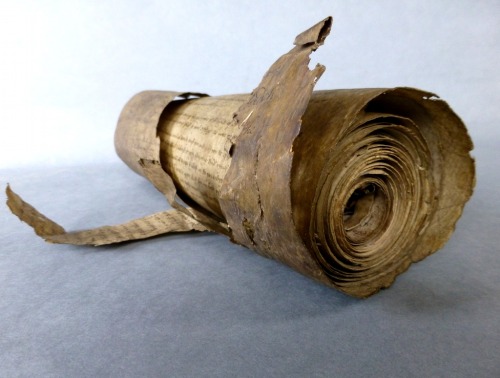 | |
| Armburgh Roll, Manchester, John Rylands Library Chetham's MS Mun.E.6.10(4) |
But it wasn’t that simple. To be sure, the Middle Ages represent centuries of experimenting with, developing, discovering the potential of the codex. But medieval people used scrolls and rolls, too. (By the way, although the two terms can be interchangeable, it is useful to distinguish between a scroll, which is opened horizontally, and a roll, which is opened vertically.) In England, in particular, rolls were used for legal, financial, and government records from the 12th to the 19th centuries. Other types of text, particularly genealogies, were also written on scrolls or rolls. Richard Rouse argued in 1982 that rolls may have been a common format for lyrics or similar texts intended for performance, although hardly any examples survive. The only surviving roll containing a medieval literary text in English is British Library MS Additional 23986, which has the short English play Interludium de clerico et puella on one side and an Anglo-French political poem on the other. I use the present tense hopefully; the manuscript seems to have disappeared from the British Museum in 1971.
Why did people use scrolls and especially rolls in medieval England? What kinds of texts were they associated with? How did the physical form of scrolls and rolls affect the ways in which they were read? Why did the use of scrolls and rolls persist so stubbornly for certain kinds of texts?
 In digital reading environments, it is common not to flip pages (nostalgic turning-the-pages animations notwithstanding) but to ‘scroll’ up and down; you probably did that to get to what you're reading now. Why do designers of these interfaces choose scrolling (or rolling) rather than other ways of moving the reader through text? How does scrolling on a screen differ from the experience of unrolling a medieval manuscript?
In digital reading environments, it is common not to flip pages (nostalgic turning-the-pages animations notwithstanding) but to ‘scroll’ up and down; you probably did that to get to what you're reading now. Why do designers of these interfaces choose scrolling (or rolling) rather than other ways of moving the reader through text? How does scrolling on a screen differ from the experience of unrolling a medieval manuscript? One possibility raised by these questions is that scrolls and rolls present textual information in a linear, ‘flattened’, and (at most) two-dimensional format. This may be one reason why they seem to have been associated with public and/or spoken (or sung) texts. A scroll lays it all out if you choose to unroll it completely; the codex hides everything except the opening you are looking at. We’ll have to think a little harder about how scrolling up and down on a screen provides a reading experience that’s different from either of these.
Yin Liu
Lots of references:
Cavallo, Guglielmo. ‘Between Volumen and Codex: Reading in the Roman World.’ In A History of Reading in the West. Ed. Guglielmo Cavallo and Roger Chartier. Trans Lydia G. Cochrane. Amherst: U of Massachusetts P, 1999. 64-89.
Clanchy, M. T. From Memory to Written Record. 3rd ed. Wiley, 2012.
Clemens, Raymond, and Timothy Graham. Introduction to Manuscript Studies. Ithaca: Cornell UP, 2007.
Frost, Gary. ‘Adoption of the Codex Book: Parable of a New Reading Mode.’ Book and Paper Annual 17 (1998).
Mak, Bonnie. How the Page Matters. Toronto: U of Toronto P, 2011.
Paden, William D. ‘Lyrics on Rolls.’ In ‘Li Premerains Vers.’ Ed. Catherine M. Jones and Logan E. Whalen. Rodopi, 2011. 325-340.
Roberts, Colin H., and T. C. Skeat. The Birth of the Codex. London: Oxford UP, 1983.
Rouse, Richard H. ‘Roll and Codex: The Transmission of the Works of Reinmar von Zweter.’ Münchener Beiträge zur Mediävistik und Renaissance-Forschung 32 (1982): 107-123. Rpt. in Mary A. Rouse and Richard H. Rouse, Authentic Witnesses: Approaches to Medieval Texts and Manuscripts. Notre Dame: U of Notre Dame P, 1991. 13-29.
Steiner, Emily. Documentary Culture and the Making of Medieval English Literature. Cambridge: Cambridge UP, 2003.
Taylor, Andrew. ‘The Myth of the Minstrel Manuscript.’ Speculum 66.1 (1991): 43-73.
No comments :
Post a Comment